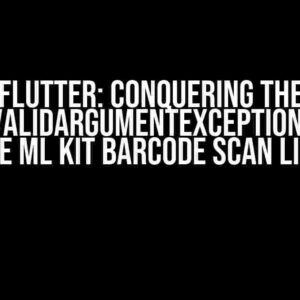Are you tired of seeing the infamous “ERROR: duplicate key value violates unique constraint” exception pop up in your Spring Boot application? Do you feel like you’re stuck in a never-ending cycle of frustration and uncertainty? Fear not, dear developer! This article is here to guide you through the treacherous waters of error handling and equip you with the knowledge to tackle this pesky error once and for all.
What’s Behind the Error?
Before we dive into the solutions, let’s take a step back and understand what’s causing this error in the first place. In essence, this exception is thrown when your application attempts to insert a duplicate value into a database column that’s defined as unique. Sounds simple, right? But, as we all know, simplicity can be deceiving.
There are several scenarios that can lead to this error, including:
- Accidental duplicate data entry: Let’s face it, we’re all human, and mistakes happen. Sometimes, we might unintentionally insert duplicate data, which can cause this error to occur.
- Concurrent modifications: In a multi-user environment, it’s possible for multiple users to attempt to insert the same data simultaneously, resulting in duplicate key value violations.
- Data migration or import issues: When migrating or importing data, it’s easy to overlook unique constraints, leading to this error.
- Schema changes or db updates: Making changes to your database schema or updating your database can sometimes cause existing data to violate unique constraints.
Exception Handling Strategies
Now that we’ve identified the culprits, let’s explore some strategies to handle this error in your Spring Boot application.
1. Catch and Log the Exception
A simple yet effective approach is to catch the exception and log it for further analysis. This way, you can identify the root cause of the error and take corrective action.
try {
// Code that might throw the exception
userRepository.save(user);
} catch (DataIntegrityViolationException e) {
log.error("Duplicate key value violates unique constraint: {}", e.getMessage());
// Handle the error, e.g., return an error response to the user
}
2. Implement a Unique Constraint Check
Before attempting to insert data, you can implement a check to ensure that the unique constraint is not violated. This can be done using a simple query to check if the data already exists in the database.
if (!userRepository.existsByUsername(user.getUsername())) {
userRepository.save(user);
} else {
// Handle the error, e.g., return an error response to the user
log.error("Duplicate username: {}", user.getUsername());
}
3. Use a Transactional Approach
In a multi-user environment, using transactions can help prevent concurrent modifications that might lead to duplicate key value violations. Spring Boot provides excellent support for transactions through the `@Transactional` annotation.
@Transactional
public voidsaveUser(User user) {
userRepository.save(user);
}
4. Use a Custom Error Handler
You can create a custom error handler to catch the exception and return a meaningful error response to the user. This approach allows you to decouple error handling from your business logic.
@RestControllerAdvice
public class CustomErrorHandler {
@ExceptionHandler(DataIntegrityViolationException.class)
public ResponseEntity<String> handleDuplicateKeyError(DataIntegrityViolationException e) {
return ResponseEntity.badRequest().body("Duplicate key value violates unique constraint");
}
}
Error Handling Best Practices
When handling errors, it’s essential to follow best practices to ensure that your application remains robust and maintainable. Here are some tips to keep in mind:
- Log errors**: Logging errors provides valuable insights into what’s going wrong and helps you identify patterns and trends.
- Handle errors locally**: Catch and handle errors as close to the source as possible to minimize the impact on your application.
- Use meaningful error messages**: Provide clear and concise error messages that help users understand what went wrong.
- Test error handling**: Verify that your error handling mechanisms are working correctly by writing tests for error scenarios.
- Document error handling**: Document your error handling strategies and best practices to ensure that your team is on the same page.
Conclusion
In conclusion, handling the “ERROR: duplicate key value violates unique constraint” exception in Spring Boot requires a combination of error handling strategies, best practices, and a solid understanding of what causes this error. By following the tips and techniques outlined in this article, you’ll be well-equipped to tackle this error and provide a better user experience for your application.
Remember, error handling is not a one-size-fits-all solution. Be prepared to adapt and evolve your strategies as your application grows and changes.
| Error Handling Strategy | Description |
|---|---|
| Catch and Log the Exception | Catch the exception and log it for further analysis. |
| Implement a Unique Constraint Check | Check if the data already exists in the database before attempting to insert it. |
| Use a Transactional Approach | Use transactions to prevent concurrent modifications that might lead to duplicate key value violations. |
| Use a Custom Error Handler | Create a custom error handler to catch the exception and return a meaningful error response to the user. |
Frequently Asked Question
Hey there, fellow Spring Boot enthusiasts! Have you ever encountered the dreaded “ERROR: duplicate key value violates unique constraint” exception? Don’t worry, we’ve got you covered! Here are some frequently asked questions and answers on how to handle this pesky error:
Q: What causes the “duplicate key value violates unique constraint” exception in Spring Boot?
A: This exception occurs when you’re trying to insert a record with a duplicate value in a column that has a unique constraint. It means you’re attempting to add a duplicate value to a column that’s set up to only allow unique values, such as a primary key or a unique identifier.
Q: How do I identify the duplicate value causing the error?
A: To identify the duplicate value, you can enable SQL logging in your Spring Boot application. This will allow you to see the actual SQL query that’s causing the error, making it easier to pinpoint the duplicate value. You can do this by adding the following configuration to your application.properties file: `spring.jpa.show-sql=true`.
Q: Can I ignore the duplicate value and continue with the insertion?
A: Yes, you can ignore the duplicate value and continue with the insertion using the `on duplicate key ignore` statement in your SQL query. However, be cautious when using this approach, as it can lead to data inconsistencies. A better approach would be to handle the exception and provide a meaningful error message to the user.
Q: How do I handle the exception in my Spring Boot controller?
A: You can handle the exception in your Spring Boot controller by using a try-catch block to catch the `DataIntegrityViolationException`. This exception is thrown by Spring Boot when a unique constraint is violated. You can then provide a meaningful error message to the user, or log the error for further investigation.
Q: Can I prevent the exception from occurring in the first place?
A: Yes, you can prevent the exception from occurring by validating the data before inserting it into the database. This can be done using a service layer that checks for existing records with the same unique value. You can also use a unique validator to check for duplicates before inserting the data.


